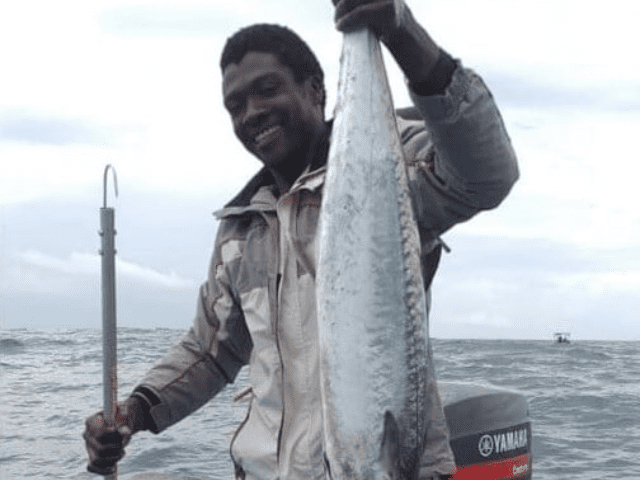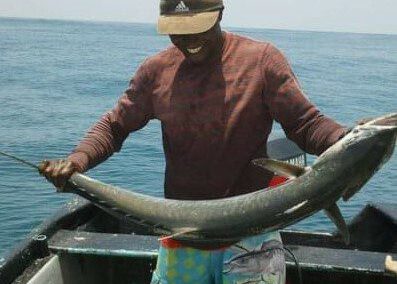Contents
Cahuita Fishing in Costa Rica | with Local Fishermen
Cahuita Fishing Tours guided by Local Fishermen. The old-school and traditional way of fishing in Costa Rica. The fish you bring home and prepare for dinner. Some older fishermen still work with the old conventional methods, like hand lines .
The fishing tours offered are two kinds of fishing:
A] Trolley Fishing with Live Bait
B] Vertical Fishing [Bottom Fishing]
The fishing is at the Protected Reef of Cahuita National Park and around the Cahuita Sea during weather conditions and the best fishing spots.
Cahuita Fishing in Costa Rica Tour – What to Expect?
First you make a choice, which kind of fishing techniques, your prefer:
A] Trolley Fishing with Live Bait
Fish which are often catched are for example the Yellowfin Tuna, Mackerel, Kingfish, Barracuda, Tuna Bonito and Dolfin Fish [Mahi-mahi].
B] Vertical Fishing [Bottom Fishing].
Fish which are often catched are for example Snapper, Grooper, Mackerel, Amber Jacks, and many kind of other fish species.
The tour starts at 4:45 AM in the morning. After you are introduced to the Fishing Captain, you will leave before Sunrise, to the best fishing waters of Cahuita, nearby the Cahuita Marine Park. We do not fish at the protected reef of the Cahuita Marine park, but nearby, at the best fishing spots, which of course depend on the fishing technique.
Depending, on the fishing tour, the captain, shows local local techniques to catch bait fish with fishing nets. For live bait fishing Sardines are catched. In case of vertical also called bottom fishing, the bait are in most cases shrimps.
During the fishing, often Dolfins and Turtles are spotted, but that can not be guanteed of course.
As you fish complete on yourself of course, all equipment is provided, you have the real life experience of fishing, so you can not compare with the fishing with Big Game fishing boats, where you most often have to make shifts to cath the big fish, and the spears to get the catched fish are only used by the staff.
You have to do it all yourself, or course support will be given if needed. The fish you bring home and prepare for dinner. Or, upon your request, you can release them.
The boats are about 30 feet long and made from fiberglass.
We fish not only nearby [not at] the Protected Reef of Cahuita but also miles from the coast, depending on weather conditions and the preferred fishing techniques of the different tours.
Meeting Point
The meeting point is at the entrance of the Cahuita Marine Park next to the small harbor; from there, you will meet your The fishing Captian, which is experienced Local Fisherman and Guide.. Here we board over to the sea of the National Park of Cahuita.
In some cases, combining fishing with a snorkeling tour is possible. With bad weather conditions, fishing is not possible for safety reasons.
Of course, all fishing gear is included, but upon preference, you can bring your own fishing gear.
Duration
Approximately: 4 to 4,5 hours, the best time to fish is from 4:45 am till 9 am. Other times are only possible upon request, in exceptional cases!
What to bring with you
Water, sunblock, insect repellent, closed shoes, sunglasses, bottled water, and a jacket for a boat trip, and your camera.
Our Tour guides
Our guides are genuinely local and experienced tour professionals. They harbor a sincere and profound passion for nature and wildlife, deeply respect Costa Rican culture, are thoroughly prepared, and are licensed by the ICT (Costa Rican Tourism Institute).
Our fishing Tour guides will join you during the trip, and these Local fishermen are very experienced and love to show you the different techniques of fishing based on their advanced experience.
What is Included
A local fishing tour guide, fresh fruits, fishing license fees, of course the fishing equipment [gear] and bait, and the fish you catch!
Pricing
A] Trolley Fishing with Live Bait
For pricing, see the shop product page. It depends on the group size. The group size of Trolley Fishing is a minimum of 2 and a maximum of 4 people. The price shown is based upon a group size of 4 people.
B] Vertical Fishing [Bottom Fishing]
For pricing, see the shop product page. It depends on the group size. The group size of Vertical Fishing is a minimum of 2 and a maximum of 6 people. The price shown is based upon a group size of 4 people.
Meeting Point and Directions
The meeting point is at the entrance of the Snorkeling House next to the Small Harbor [located at the entrance of Marine Park of National Park of Cahuita], not later than 4:45 AM.
Cahuita Fishing in Costa Rica | Trolley Fishing with Live Bait
Trolley Fishing, also called trolling, is a technique where one or more fishing lines with lures or bait fish are drowned through the water. It is an exciting technique of fishing where lines move behind the boat.
A variety of predatory like for example the Yellowfin Tuna, Mackerel, Kingfish, Barracuda, Tuna Bonito and Dolfin Fish [Mahi-mahi], Tarpon, barracuda, and, if lucky, a merlin can be caught.
Live Bait Fishing is fishing with small fish to attract the predator fish; it can be done with different kinds of live bait, like small fish, crabs, shrimps, worms, and more.
It is done in many ways; fishing with lures is akin to hunting, while bait fishing is more like trapping.
In other words, the bait fisher sets out his or her “traps” (baited hooks) and waits for the predator fish to stumble upon them. In contrast, a lure fisher can cover more water in less time.
For the trolley fishing with “live bait”, Sardines are catched.
Cahuita Fishing in Costa Rica | Bottom [Vertical] Sea Fishing
Fishing vertically is, as the name suggests, dropping a line straight down from a boat and trying to get the fish to bite. It is best to use a jig lure or a fish as dead live bait. This method is also known as jigging.
Often shrimps are used as bait.
The Protected Reef of Cahuita National Park
The Reef in the Cahuita National Park is protected and can only be visited with the assistance of tour guides with a permit.
It is the largest fringing Reef in the Caribbean in the country. The most popular is that it contains over 500 acres of Coral Reef.
This Reef consists of three barriers, and it is a protected reef; the outer barrier stretches for 3 miles from the Western side of Punta Cahuita to the Eastern side, and it is separated from the coast between 100 meters and 1.5 miles.
It is also a nesting ground for sea turtles, but that is not all you will see if you go (scuba-diving) or snorkeling. The Reef has over 240 marine life, including tropical fish species, sea urchins, cucumbers, mollusks, and crustaceans.
Worthwhile is also asking our tour guides for information to visit The Turtles Rescue Foundation of Cahuita, which acts as a community protector of the native wildlife in the area, therefore ensuring the survival of the sea turtles and guarding the natural treasures.
The Cahuita Reef inherent the coralline Reef of Cahuita, with at least 35 species of coral, over 120 species of fish, like stingrays, blue parrot fish, angelfish and barracudas, manta rays, and even three types of sharks.
Cahuita Fishing in Costa Rica | Discover Native Fishing Methods









